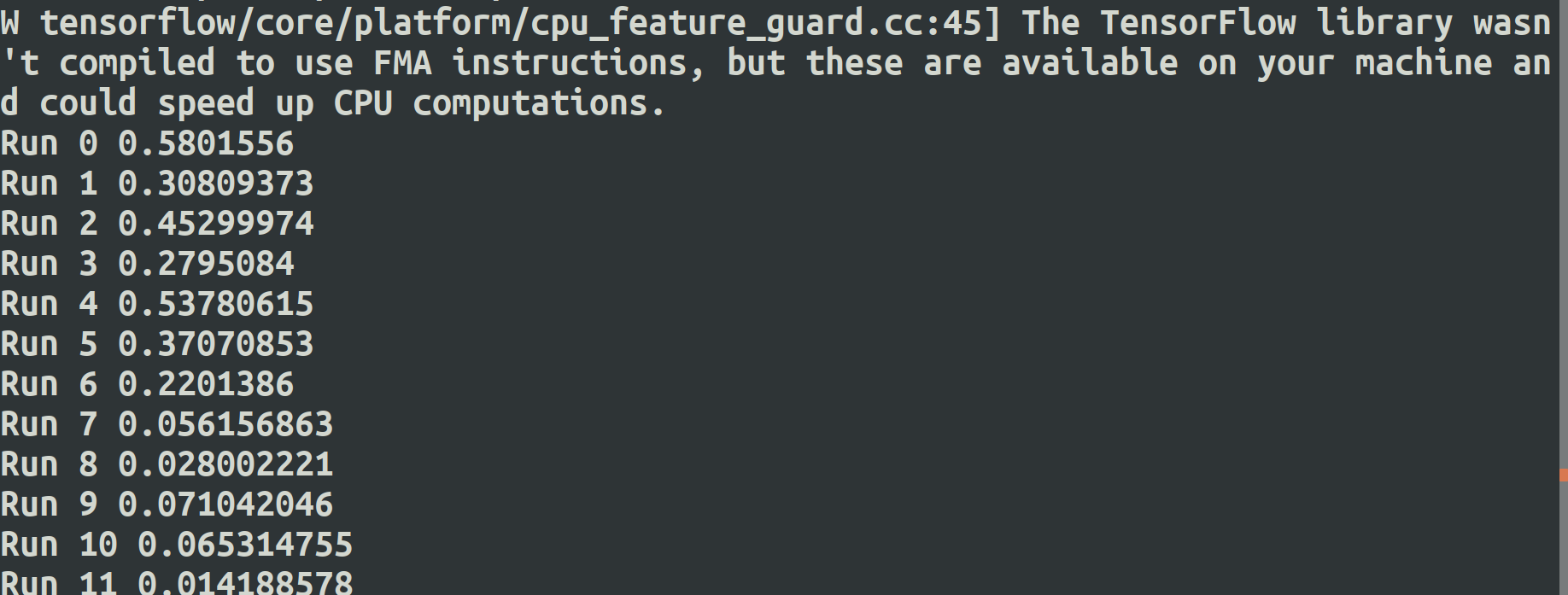Tensorflow 循环神经网络 基本 RNN 和 LSTM 网络 拟合、预测sin曲线
时序预测一直是比较重要的研究问题,在统计学中我们有各种的模型来解决时间序列问题,但是最近几年比较火的深度学习中也有能解决时序预测问题的方法,另外在深度学习领域中时序预测算法可以解决自然语言问题等。
在网上找到了 tensorflow 中 RNN 和 LSTM 算法预测 sin 曲线的代码,效果不错。
LSTM:
#encoding:UTF-8 import random
import numpy as np
import tensorflow as tf
from tensorflow.contrib.rnn.python.ops import core_rnn
from tensorflow.contrib.rnn.python.ops import core_rnn_cell def build_data(n):
xs = []
ys = []
for i in range(0, 2000):
k = random.uniform(1, 50) x = [[np.sin(k + j)] for j in range(0, n)]
y = [np.sin(k + n)] # x[i] = sin(k + i) (i = 0, 1, ..., n-1)
# y[i] = sin(k + n)
xs.append(x)
ys.append(y) train_x = np.array(xs[0: 1500])
train_y = np.array(ys[0: 1500])
test_x = np.array(xs[1500:])
test_y = np.array(ys[1500:])
return (train_x, train_y, test_x, test_y) length = 10
time_step_size = length
vector_size = 1
batch_size = 10
test_size = 10 # build data
(train_x, train_y, test_x, test_y) = build_data(length)
print(train_x.shape, train_y.shape, test_x.shape, test_y.shape) X = tf.placeholder("float", [None, length, vector_size])
Y = tf.placeholder("float", [None, 1]) # get lstm_size and output predicted value
W = tf.Variable(tf.random_normal([10, 1], stddev=0.01))
B = tf.Variable(tf.random_normal([1], stddev=0.01)) def seq_predict_model(X, w, b, time_step_size, vector_size):
# input X shape: [batch_size, time_step_size, vector_size]
# transpose X to [time_step_size, batch_size, vector_size]
X = tf.transpose(X, [1, 0, 2]) # reshape X to [time_step_size * batch_size, vector_size]
X = tf.reshape(X, [-1, vector_size]) # split X, array[time_step_size], shape: [batch_size, vector_size]
X = tf.split(X, time_step_size, 0) # LSTM model with state_size = 10
cell = core_rnn_cell.BasicLSTMCell(num_units=10,
forget_bias=1.0,
state_is_tuple=True)
outputs, _states = core_rnn.static_rnn(cell, X, dtype=tf.float32) # Linear activation
return tf.matmul(outputs[-1], w) + b, cell.state_size pred_y, _ = seq_predict_model(X, W, B, time_step_size, vector_size)
loss = tf.square(tf.subtract(Y, pred_y))
train_op = tf.train.GradientDescentOptimizer(0.001).minimize(loss) with tf.Session() as sess:
tf.global_variables_initializer().run() # train
for i in range(50):
# train
for end in range(batch_size, len(train_x), batch_size):
begin = end - batch_size
x_value = train_x[begin: end]
y_value = train_y[begin: end]
sess.run(train_op, feed_dict={X: x_value, Y: y_value}) # randomly select validation set from test set
test_indices = np.arange(len(test_x))
np.random.shuffle(test_indices)
test_indices = test_indices[0: test_size]
x_value = test_x[test_indices]
y_value = test_y[test_indices] # eval in validation set
val_loss = np.mean(sess.run(loss,
feed_dict={X: x_value, Y: y_value}))
print('Run %s' % i, val_loss) for b in range(0, len(test_x), test_size):
x_value = test_x[b: b + test_size]
y_value = test_y[b: b + test_size]
pred = sess.run(pred_y, feed_dict={X: x_value})
for i in range(len(pred)):
print(pred[i], y_value[i], pred[i] - y_value[i])

RNN :
import random import numpy as np
import tensorflow as tf
from tensorflow.contrib.rnn.python.ops import core_rnn
from tensorflow.contrib.rnn.python.ops import core_rnn_cell def build_data(n):
xs = []
ys = []
for i in range(0, 2000):
k = random.uniform(1, 50) x = [[np.sin(k + j)] for j in range(0, n)]
y = [np.sin(k + n)] # x[i] = sin(k + i) (i = 0, 1, ..., n-1)
# y[i] = sin(k + n)
xs.append(x)
ys.append(y) train_x = np.array(xs[0: 1500])
train_y = np.array(ys[0: 1500])
test_x = np.array(xs[1500:])
test_y = np.array(ys[1500:])
return (train_x, train_y, test_x, test_y) length = 10
time_step_size = length
vector_size = 1
batch_size = 10
test_size = 10 # build data
(train_x, train_y, test_x, test_y) = build_data(length)
print(train_x.shape, train_y.shape, test_x.shape, test_y.shape) X = tf.placeholder("float", [None, length, vector_size])
Y = tf.placeholder("float", [None, 1]) # get lstm_size and output predicted value
W = tf.Variable(tf.random_normal([10, 1], stddev=0.01))
B = tf.Variable(tf.random_normal([1], stddev=0.01)) def seq_predict_model(X, w, b, time_step_size, vector_size):
# input X shape: [batch_size, time_step_size, vector_size]
# transpose X to [time_step_size, batch_size, vector_size]
X = tf.transpose(X, [1, 0, 2])
# reshape X to [time_step_size * batch_size, vector_size]
X = tf.reshape(X, [-1, vector_size])
# split X, array[time_step_size], shape: [batch_size, vector_size]
X = tf.split(X, time_step_size, 0) cell = core_rnn_cell.BasicRNNCell(num_units=10)
initial_state = tf.zeros([batch_size, cell.state_size])
outputs, _states = core_rnn.static_rnn(cell, X, initial_state=initial_state) # Linear activation
return tf.matmul(outputs[-1], w) + b, cell.state_size pred_y, _ = seq_predict_model(X, W, B, time_step_size, vector_size)
loss = tf.square(tf.subtract(Y, pred_y))
train_op = tf.train.GradientDescentOptimizer(0.001).minimize(loss) with tf.Session() as sess:
tf.global_variables_initializer().run() # train
for i in range(50):
# train
for end in range(batch_size, len(train_x), batch_size):
begin = end - batch_size
x_value = train_x[begin: end]
y_value = train_y[begin: end]
sess.run(train_op, feed_dict={X: x_value, Y: y_value}) # randomly select validation set from test set
test_indices = np.arange(len(test_x))
np.random.shuffle(test_indices)
test_indices = test_indices[0: test_size]
x_value = test_x[test_indices]
y_value = test_y[test_indices] # eval in validation set
val_loss = np.mean(sess.run(loss,
feed_dict={X: x_value, Y: y_value}))
print('Run %s' % i, val_loss) for b in range(0, len(test_x), test_size):
x_value = test_x[b: b + test_size]
y_value = test_y[b: b + test_size]
pred = sess.run(pred_y, feed_dict={X: x_value})
for i in range(len(pred)):
print(pred[i], y_value[i], pred[i] - y_value[i])

-------------------------------------------------------------------
Tensorflow 循环神经网络 基本 RNN 和 LSTM 网络 拟合、预测sin曲线的更多相关文章
- 深度学习项目——基于循环神经网络(RNN)的智能聊天机器人系统
基于循环神经网络(RNN)的智能聊天机器人系统 本设计研究智能聊天机器人技术,基于循环神经网络构建了一套智能聊天机器人系统,系统将由以下几个部分构成:制作问答聊天数据集.RNN神经网络搭建.seq2s ...
- 大话循环神经网络(RNN)
在上一篇文章中,介绍了 卷积神经网络(CNN)的算法原理,CNN在图像识别中有着强大.广泛的应用,但有一些场景用CNN却无法得到有效地解决,例如: 语音识别,要按顺序处理每一帧的声音信息,有些结果 ...
- Coursera Deep Learning笔记 序列模型(一)循环序列模型[RNN GRU LSTM]
参考1 参考2 参考3 1. 为什么选择序列模型 序列模型能够应用在许多领域,例如: 语音识别 音乐发生器 情感分类 DNA序列分析 机器翻译 视频动作识别 命名实体识别 这些序列模型都可以称作使用标 ...
- 【学习笔记】循环神经网络(RNN)
前言 多方寻找视频于博客.学习笔记,依然不能完全熟悉RNN,因此决定还是回到书本(<神经网络与深度学习>第六章),一点点把啃下来,因为这一章对于整个NLP学习十分重要,我想打好基础. 当然 ...
- TensorFlow(十一):递归神经网络(RNN与LSTM)
RNN RNN(Recurrent Neural Networks,循环神经网络)不仅会学习当前时刻的信息,也会依赖之前的序列信息.由于其特殊的网络模型结构解决了信息保存的问题.所以RNN对处理时间序 ...
- CNN(卷积神经网络)、RNN(循环神经网络)、DNN,LSTM
http://cs231n.github.io/neural-networks-1 https://arxiv.org/pdf/1603.07285.pdf https://adeshpande3.g ...
- 深度学习之循环神经网络(RNN)
循环神经网络(Recurrent Neural Network,RNN)是一类具有短期记忆能力的神经网络,适合用于处理视频.语音.文本等与时序相关的问题.在循环神经网络中,神经元不但可以接收其他神经元 ...
- TensorFlow——循环神经网络基本结构
1.导入依赖包,初始化一些常量 import collections import numpy as np import tensorflow as tf TRAIN_DATA = "./d ...
- [深度学习]理解RNN, GRU, LSTM 网络
Recurrent Neural Networks(RNN) 人类并不是每时每刻都从一片空白的大脑开始他们的思考.在你阅读这篇文章时候,你都是基于自己已经拥有的对先前所见词的理解来推断当前词的真实含义 ...
随机推荐
- jmeter+python+sh执行优化报告(一)
缘由: 1)jmeter生成的html报告容量偏大 2)jmeter生成的报告,没有历史统计 3)此外,该目录整体可以整合的自动化平台内 故:做了调整~ 一.目录结构 1)scriptPy文件夹:主要 ...
- P,R,F1 等性能度量(二分类、多分类)
总结自<机器学习>周志华 2.3 目录 最常用的是查准率P(precision),查全率R(recall),F1 一.对于二分类问题 二.对于多分类问题 1.macro 2.micro 最 ...
- linux文档与目录结构
Linux文件系统结构 本文转自 https://www.cnblogs.com/pyyu/p/9213237.html Linux目录结构的组织形式和Windows有很大的不同.首先Linux没有“ ...
- Easy sssp(spfa判负环与求最短路)
#include<bits/stdc++.h> using namespace std; int n,m,s; struct node{ int to,next,w; }e[]; bool ...
- Django之路——10 django的分页组件
Django的分页器(paginator) view from django.shortcuts import render,HttpResponse # Create your views here ...
- 通过php安装Imagick扩展给动态gif图片打水印
通过php安装Imagick扩展给动态gif图片打水印 一直以来php处理图片都是以gd为主流,直到近些年Imagick的使用才渐渐变多. gd通常用来缩放图片,给图片打水印等基本功能,对于复杂效果如 ...
- Dubbo源码分析(3):ExtensionFactory
通过ExtensionFactory的getExtension方法获取目标对象.ExtensionFactory实现有两个,一个基于SPI的,一个Spring的ApplicationContext的. ...
- Acwing P298 围栏
Analysis ①首先将所有粉刷匠,按照必须刷的小木块Si从小到大排序. 上面这个操作为了保证我们可以顺序处理. ②我们可以设f[i][j]表示为,前i个粉刷匠,刷了前i个木块.可以有些木块选择不刷 ...
- 15、Work原理及源码分析
一.Work原理 1.图解 Worker启动Driver的一个基本原理,就是Worker内部会启动一个线程,这个线程可以理解为,就是DriverRunner,然后DriverRunner就会去负责启动 ...
- 14、master原理与源码分析
一.主备切换机制原理剖析 1.图解 2.部分源码 ###master.scala中的completeRecovery方法: /* * 完成Master的主备切换 */ def completeReco ...
